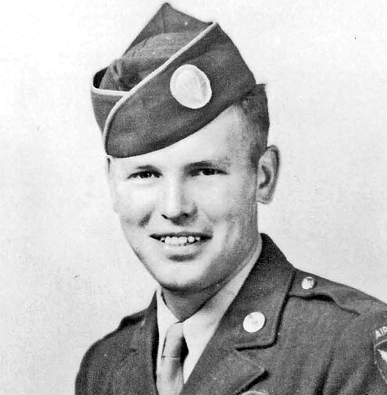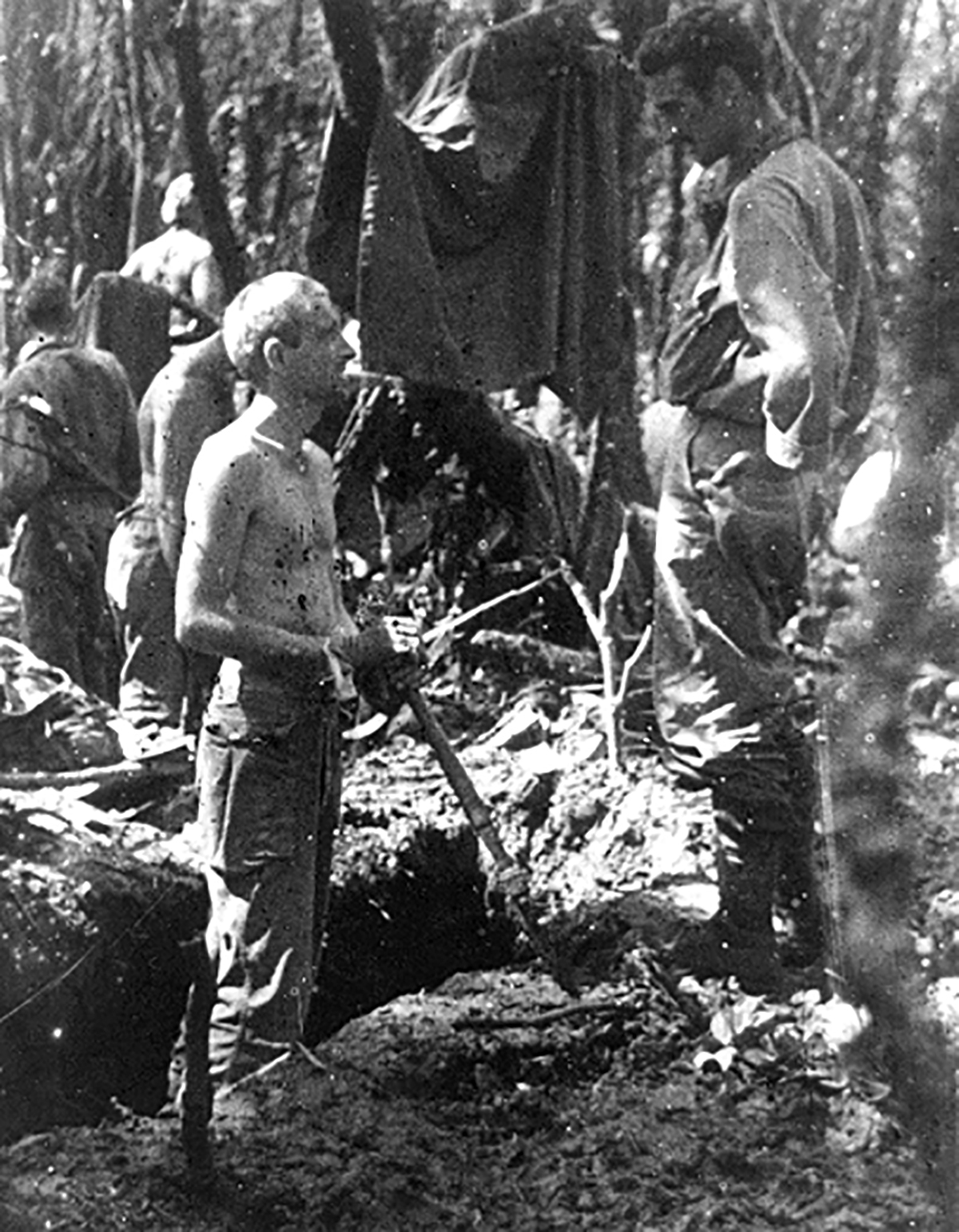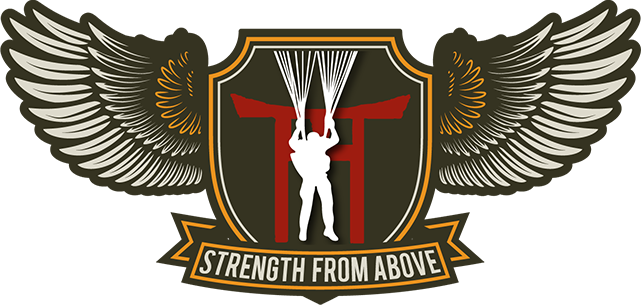The Battle for Mt. Bijang - 4: Hilltop Battle
Article Index
The Hilltop Battle
The Angels disengaged safeties and placed grenades on the ground with loosened pins. Knives were jammed in the soil for quick reach and quiet whispers of encouragement were traded between friends while officers and NCOs moved between positions with words of direction.
When the first of the enemy did arrive, the company's two machine guns and the entire 3rd Platoon opened fire and an after-action report notes, "Its effect was murderous." Everything went silent, minus one squad leader calling for a medic for his two wounded men.
Several Japanese automatic weapons then opened up on 3rd Platoon’s positions and fire was called in from the 60mm mortar squad located to the rear which delivered four rounds on target. So far, things seemed to be going in the ANgels' favor.
 Then, around 1300, 3rd Platoon’s T/SGT Edwin "Ed" Leo Sorenson (pictured right), who was positioned on the company’s right flank, noticed a small dirt trail surrounded by brush and bushes that led down the hillside. Perhaps it was sixth sense, but Ed felt to throw a phosphorous grenade into the hole. He said:
Then, around 1300, 3rd Platoon’s T/SGT Edwin "Ed" Leo Sorenson (pictured right), who was positioned on the company’s right flank, noticed a small dirt trail surrounded by brush and bushes that led down the hillside. Perhaps it was sixth sense, but Ed felt to throw a phosphorous grenade into the hole. He said:
"Guess what – two or three Japanese trotted up the trail from me, no more than 30 to 50 feet away. I began shooting as they reached the top. I had two more grenades and each one I threw brought 2 or 3 more of the enemy. So, I had me a shooting gallery. The foregoing sounds very well, but I followed that with the worst sin a platoon sergeant can commit. I sent a very bright young assistant machine gunner to a position about 20 feet away from me, expecting him to be covered by the trees at the head of the draw. I was wrong, and no sooner had he put the tripod down than he was dead. I stared in disbelief and have shed tears for this young man that I did not have time for as he lay dying."
Then things got worse.
"All of a sudden, all hell broke loose," wrote medic PFC Alfred Haarof Freeman, South Dakota. “The Japs attacked us on two sides and were attempting to get behind us...”
“They really came after us,” PFC Billy Pettit added.
“It was a real battle,” Grandpa exclaimed. “They really did a good job.”
While initial reports indicated that D Company would only face a light rifle platoon or reinforced company on Mt. Bijang, Intelligence had clearly underestimated the enemy.
"We could hear them shouting and yelling, working themselves up before the attack," noted PFC Bill Dubes who would soon be wounded in the shoulder by shrapnel. "A fire had started, whether intentional or not, the smoke and ashes complicated the situation. It’s hard to know how many casualties we inflicted on them, but they hit a lot of us with mortar fire and rifle and machine gun fire."
The initial enemy barrages left D Company with eight new casualties (six wounded, two dead) which were evacuated to 2nd Platoon’s position at 1330, half an hour into the counterattack. Watching the massing bellowing Japanese, CPT Cavanaugh sent word for the artillery liaison officer to call in fire missions.
"Our artillery observer took immediate action to bring the enemy positions under fire," Rusty noted. "But the trajectory of the howitzer rounds was too flat to reach the enemy, which were within a few hundred yards of us and protected by the reverse crest of the hill… I recall the artillery shells coming in from our supporting battery passing so close over our heads that we could almost have touched them."
When the artillery liaison asked if the batteries should lower trajectory, Rusty shouted, "No, don't fire any lower! We’re scratching matches on them now."
While the Angels' artillery support roared harmlessly overhead, the attacking Japanese rained down knee-mortars at the rate of over 20-30 rounds a minute. While many were duds, the mortar rounds, only lethal within fifteen feet, inflicted several additional casualties. CPT Cavanaugh even remembered looking up from his rifle sight to watch the mortar shells arcing overhead.
"Being a mortar gunner, I knew the Japanese had zeroed in on us," remembered PFC Elmer "Chuck" Hudson. "One shell fell to the right of me and then another shell to the left. The next shell was coming down the middle. I could see several shells in the air coming right down my throat! I protected my face with my right arm, and caught five pieces of shrapnel in the arm, saving a hit to my head. This shell moved me back about 20 feet."
"I heard a solder yell, 'I have a man killed over here!'" Chuck continued. "I never did pass out, nor did I have any pain for about 10 minutes. Al Harr, our Medic, got to me and gave me a shot of morphine, and took care of me like a professional. He laid me down behind a hole and asked for my rifle, but I told him, 'I want to keep my rifle.'"
From his position between 1st and 2nd Platoons, CPT Cavanaugh opened fire on one of the enemy mortarmen 50 yards away, but without success. He noted with frustration, "I must have fired three clips at that bobbing back and I don’t think I ever hit him."
By now, D Company had been engaged with the enemy for roughly an hour so at 1400 Rusty sent a request back to Regiment via radioman PFC Roy Lipanovich for ammunition, grenades, water. The response came back at 1410 that the carrying party would leave Sugar Central at 1500 courtesy of S-4 LT Roy Stout. PFC Lipanovich then shouted for Rusty's attention once more and the young captain turned to watch an enemy bullet shockingly fly through his radioman's jaw.
Screaming for a medic, CPT Cavanaugh also learned from a runner that 1st Platoon's CO, 2LT James W. Osmun, Jr. of Hazen, Nevada, had been seriously wounded.
"Actually, he had been hit above the eye and the eye was driven out of his head and was hanging from the socket," Rusty grimly pointed out. I recently discovered that not only did 2LT Osmun survive, but the former 37th Infantry Division member went on to study at the University of Nevada before marrying Iona May Allen on January 25, 1946.
The paratroopers in 3rd and 1st Platoons could see Japanese soldiers moving behind a protective rise and some carefully crawled underneath their comrades’ fire to close in with 1st Platoon. One had managed to get a clear shot at LT Osmun before the offending enemy was devastatingly dispatched by the Angels’ grenades, including those of SGT Bill Dubes who saw the bullet exit Osmun’s left temple.
Bill noted, "That’s one time when I really thought maybe I wasn’t going to make it."
CPT Cavanaugh was wondering the same thing for his entire company. He estimated that I Company was still several hours away from joining them on the crest and the rate (and ferocity) of enemy fire, especially mortars, seemed to be increasing. In addition, the number of D Company's casualties was mounting as attested by the number of "patients" the medics were caring for near the Company's "CP" in the center.
D Company's young captain, who Brigadier General Henry Muller once said was "The ideal company commander", was doing his best to direct the intense action while his platoon and squad leaders maintained effective unit cohesion against the numerically superior enemy force. As Rusty continued to fire off orders, he became aware of a familiar presence by his side. Pausing from the action, Cavanaugh looked over and was surprised to see his XO, 1LT Andrew Carrico, at his side.
"He was six inches away," Rusty clarified.
"Carrico, you sunnavabitch!" he shouted. "What the hell are you doing here?! I told you to stay back...."
"My men are here," Grandpa yelled back, firing his M1. "I needed to be up here with my men."
While in the heat of battle Cavanaugh was initially upset, Grandpa's arrival was fortuitous as, again, his former men in 1st Platoon had just lost their new CO, 2LT Osmun. With bullets zipping and mortars exploding around them, Cavanaugh briefed Grandpa on the situation’s developments and they discussed the concern that if casualties continued to mount, they would have difficulty covering a withdrawal while evacuating the wounded. Acting quickly, Rusty was about to send Andy to assume command of 1st Platoon when a Japanese machine gun burst ripped into Grandpa's body.
"Steve! I’ve been hit!" Rusty glanced over to see 1LT Carrico bleeding profusely; the enemy bullet had torn through Grandpa’s right hand, nearly severing his ring finger, then bounced off his rifle stock as another bullet buried itself in his left shoulder.
Grandpa told me decades later, "I was lying in a Japanese foxhole firing, when suddenly I knew that I had been shot. I don’t recall a lot of pain, just 'knew I’d been hit'...." He then gestured with his four-fingered hand from right shoulder to left, pausing to point at his chin. "You can see how close that was to my head. I was pretty damn lucky."
Medic PFC Al Haar, who had been moving around the battlefield to treat their wounded, rushed to Andy's side to begin initial care. The selfless medic then got the bleeding XO to the company command post and had him rest near the seriously wounded 2LT Osmun and PFC Lipanovich, as well as several other wounded troopers.
"Al Haar… was a very busy fellow that day!" Grandpa remembered. "Al got to me, gave me a shot of morphine, and somebody (later) helped me off that mountain." It was actually 2LT Osmun; the two wounded lieutenants were later seen helping each other down the hill as D Company began their withdrawal.
CPT Cavanaugh later noted, "Our medics were doing their usual magnificent job, but there was a limit to their numbers and resources."
Of those frontline medics, CPL William R. Walter declared, "(Combat medics) are a breed of men by themselves. They do one of the most brave acts that can be done in the service, because the minute a wounded person calls for them, they go without hesitation, forgetting the fact that they are in the line of fire—the same line of fire that wounded the person they are tending to."
Back in his commandeered Japanese foxhole, CPT Cavanaugh raised his rifle to push in a fresh clip when an immense blow crashed into his head which spun him around and left the captain face down on the dike’s bank.
"I fault myself for being in an exposed position where I could not effectively command the company," he later lamented. Shaking off the haze, Rusty made sure his skull was intact.
"As I reached to recover (my helmet), I saw two holes in it, an entrance and an exit hole," he noted (he kept the helmet after the war). "How I escaped a serious if not fatal head wound, I’ll never know and except for a knot on my head as big as a pigeon’s egg my head was intact."
Grandpa explained that the bullet had entered the captain’s helmet and gone around the inner band and Rusty remarked with his typical self-effacing humor, "The fact that the round did not strike anything worthwhile while passing around my head came as no surprise to my company. They had long suspected I might be lacking in that area."
 Cavanaugh’s company runner T-5 Joseph E. Signor (seen in same order in a Leyte photo to the right) crawled to his position and exclaimed, "Rusty, you’re bleeding like a stuck pig!"
Cavanaugh’s company runner T-5 Joseph E. Signor (seen in same order in a Leyte photo to the right) crawled to his position and exclaimed, "Rusty, you’re bleeding like a stuck pig!"
Still dazed, Cavanaugh looked down and noticed that he had been hit in the shoulder as well. He later surmised that the same enemy soldier had hit his radio operator, his executive officer and himself.
"That machine gunner had earned his pay," Rusty noted. "I looked up and could actually see the incoming rounds. I shouldn’t have been doing what I was doing (fighting at the front), but I was there, and the counterattack was strong, and every available rifle was needed."
Slamming his aerated helmet back on his goose-egged head, Cavanaugh mentally reviewed their situation. By now D Company had suffered four killed and fifteen wounded which represented twenty percent of his already understrength force. Item Company’s arrival and the promised resupply from Regiment were still hours away. While 2nd Platoon had yet to be fully engaged, the Japanese were attacking with a sufficiently large force to cause concern and in Rusty’s mind, remaining in their position now seemed untenable. D Company was down to one grenade per man and the Angels were struggling to keep their machine guns fed with ammunition stripped from the wounded and dead and once those guns stopped firing, the enemy would likely charge en masse.
Another problem arose due to the smoke that PFC Dubes mentioned earlier (which was possibly started by SGT Sorenson’s phosphorous grenades). Since I Company’s position was unknown, the artillery officer could no longer call in fire missions without imperiling an entire company. CPT Cavanaugh was also aware that as he and Grandpa discussed, it would soon become difficult to affect a withdrawal while under fire if he lost any additional men as it would require more Angels to carry out the wounded than might be left to cover their movement.
Rusty added, "If I had not been convinced before, I certainly was now that we were in the wrong place at the wrong time."
MAJ John M. Cook, 2nd Battalion's Executive Officer, who had accompanied D Company up the hill and observed their incredible stand against the enemy carefully made his way to Rusty's foxhole. They were both veterans of the Leyte and Manila campaigns and understood the reality of the situation. D Company was well-known throughout the regiment as proficient fighters, but even Angels have their limits.
Cook turned to CPT Cavanaugh and gave the orders that Rusty himself was considering: "Prepare to withdraw with your entire company by the same way you got up here. Commence withdrawal as soon as you are ready."
3rd Platoon’s SGT Ed Sorenson then made his way to Rusty’s (and Cook's) side and was shocked to learn that every single officer in D Company had been wounded in the firefight. After briefing receiving Sorenson's report, Cavanaugh ordered Ed to organize the company’s platoons. It was time to get off the mountain.
